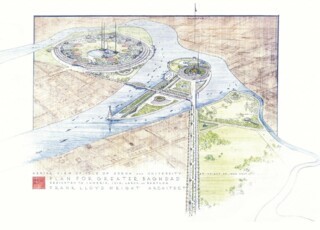At the Center for Architecture
Jason Farago · Bauhaus on the Tigris
The former Saddam Hussein Gymnasium stands on the east side of the Tigris in Baghdad, next to Iraq’s national football stadium. It was built between 1973 and 1980 to designs made by Le Corbusier in the late 1950s. He also planned a giant stadium and other facilities in advance of a mooted Olympic bid, but only the gym was built. His designs for the Olympic project were on show at the V&A a few years ago, but City of Mirages: Baghdad 1952-82, at the Center for Architecture in New York until 5 May, puts the work in a larger context.
Most of the 15 architects in the show were commissioned by the Iraqi Development Board, established in 1950 under King Faisal II after a renegotiated oil deal brought in massive new revenues. Frank Lloyd Wright’s unrealised plan for a Greater Baghdad included an opera house, museums, a university, shopping malls, and a 300-foot statue of the caliph Harun al-Rashid. The opera house was never built, but Baghdad University eventually underwent a total renovation at the hands of Walter Gropius in the late 1950s.
In 1954, the American state department began inviting modernist architects to design new embassies and missions: Eero Saarinen for London, Marcel Breuer for The Hague, Edward Durrell Stone for New Delhi. The architects were required to work in ‘an architectural form representative of the United States’ but also to show ‘neighbourly sympathy’ (Saarinen’s concrete building in Grosvenor Square was clad in Portland stone). For Baghdad they hired Josep Lluís Sert, the dean of Harvard’s Graduate School of Design. His embassy, on the west bank of the Tigris, was made up of a chancery, an ambassador’s residence and a series of gardens, parts of which were open to the public.
It wasn’t used for long: the United States abandoned the embassy in the early 1970s. And they didn’t return for it in 2003; diplomats took up instead in the Republican Palace, and now work and live in a giant, nearly windowless bunker that cost more than a billion dollars to build. Sert’s embassy, though inside the Green Zone, is a bombed-out shell. The Ministry of Foreign Affairs uses its courtyard as a parking lot.
